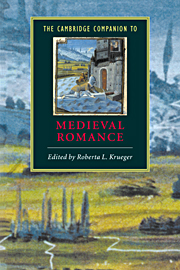Book contents
- Frontmatter
- Introduction
- Part 1 The origins, forms, and contexts of medieval romance
- Part 2 European romance and medieval society
- 5 Courts, clerks, and courtly love
- 6 The societal role of chivalry in romance
- 7 The other worlds of romance
- 8 Questions of gender in Old French courtly romance
- 9 Women and men in late medieval English romance
- Part 3 European transformations
- Editions and translations
- Index
- Series list
6 - The societal role of chivalry in romance
northwestern Europe
from Part 2 - European romance and medieval society
Published online by Cambridge University Press: 28 May 2006
- Frontmatter
- Introduction
- Part 1 The origins, forms, and contexts of medieval romance
- Part 2 European romance and medieval society
- 5 Courts, clerks, and courtly love
- 6 The societal role of chivalry in romance
- 7 The other worlds of romance
- 8 Questions of gender in Old French courtly romance
- 9 Women and men in late medieval English romance
- Part 3 European transformations
- Editions and translations
- Index
- Series list
Summary
What did medieval people mean when they used the word “chivalry” (Latin, militia, French, chevalerie)? The simplest sense was hardy deeds in a fight with edged weapons. A second meaning was social, the body of knights in one place or even all knights, thought of as a distinct group. The third meaning, more abstract, referred to their ideas and ideals, to chivalry as the ethos of the knights. All three senses of the word appear (often intertwined) in romance literature, one of our best (if least used) sources on medieval society.
Yet the historian reading romance in order to understand chivalry faces difficult questions. Historians still believe that by careful use of evidence a “real” medieval world can be partially recovered; yet how can romance, which seems so totally “unreal,” form a part of this evidence? Some scholars have thought that since it is imaginative literature, romance must be discounted as merely escapist storytelling. Some have considered the chivalry portrayed in its pages dreamlike, a thin veil pulled over the realities of a harsh world, and completely divorced from grinding social tensions or violence. An audience limited by gender would further reduce the importance of romance as historical evidence by cutting readership in half – picturing men reading (or listening in hall to) chansons de geste with their endless war and tenurial disputes; women in chamber reading the more psychological romances with love interest.
- Type
- Chapter
- Information
- The Cambridge Companion to Medieval Romance , pp. 97 - 114Publisher: Cambridge University PressPrint publication year: 2000
- 2
- Cited by

